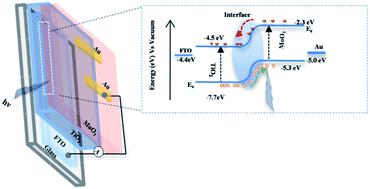当前位置:
X-MOL 学术
›
Nanoscale Adv.
›
论文详情
Our official English website, www.x-mol.net, welcomes your
feedback! (Note: you will need to create a separate account there.)
Solution processed transparent anatase TiO2 nanoparticles/MoO3 nanostructures heterojunction: high performance self-powered UV detector for low-power and low-light applications
Nanoscale Advances ( IF 4.6 ) Pub Date : 2020-12-21 , DOI: 10.1039/d0na00780c Bhuvaneshwari Ezhilmaran 1, 2 , M Dhanasekar 1, 2 , S Venkataprasad Bhat 1, 2
Nanoscale Advances ( IF 4.6 ) Pub Date : 2020-12-21 , DOI: 10.1039/d0na00780c Bhuvaneshwari Ezhilmaran 1, 2 , M Dhanasekar 1, 2 , S Venkataprasad Bhat 1, 2
Affiliation

|
Ultraviolet (UV) photodetectors are considered as the major players in energy saving technology of the future. Efforts are needed to further develop such devices, which are capable of operating efficiently at low driving potential as well as with weak illumination. Herein, we report an all-oxide, highly transparent TiO2/MoO3 bilayer film, with nanoparticulate anatase TiO2 as the platform, fabricated by a simple solution based method and demonstrate its use in UV photodetection. Photoconductivity measurement with 352 nm light reveals the self-powered UV detection capability of the device due to the built-in potential at the bilayer interface. The device exhibits a high photoresponsivity (46.05 A W−1), detectivity (2.84 × 1012 Jones) and EQE (16 223%) even with a weak illumination of 76 μW cm−2, at a low bias of only −1 V. The self-powered performance of the bilayer device is comparable to that of commercial Si photodetectors as well as other such UV detectors reported based on metal oxide heterojunctions. The improved and faster photoresponse shown by the device is due to the formation of an effective heterojunction, as evidenced by XPS, electrochemical and I–V studies. It can be further attributed to the better charge transport through the densely aligned nanostructures, reduced recombination and the better mobility of anatase TiO2 nanoparticles. The performance is best-in-class and proves the potential of the transparent heterojunction to be used in highly responsive, self-powered UV detectors for low bias, low light applications.
中文翻译:

溶液处理的透明锐钛矿 TiO2 纳米颗粒/MoO3 纳米结构异质结:适用于低功率和低光应用的高性能自供电紫外检测器
紫外线 (UV) 光电探测器被认为是未来节能技术的主要参与者。需要努力进一步开发此类器件,使其能够在低驱动电位和弱照明下高效运行。在此,我们报告了一种全氧化物、高透明的TiO 2 /MoO 3双层薄膜,以纳米颗粒锐钛矿TiO 2为平台,通过简单的基于溶液的方法制备,并展示了其在紫外光电检测中的用途。使用 352 nm 光进行光电导测量揭示了由于双层界面处的内置电势而产生的自供电紫外检测能力。即使在 76 μW cm -2的弱照明和仅 -1 V 的低偏压下,该器件也表现出高光响应度(46.05 AW -1 )、探测率(2.84 × 10 12 Jones)和 EQE(16 223%)。该双层器件的自供电性能可与商用硅光电探测器以及基于金属氧化物异质结报道的其他此类紫外探测器相媲美。 XPS、电化学和I - V研究证明,该器件所表现出的改进且更快的光响应是由于有效异质结的形成。这可以进一步归因于通过密集排列的纳米结构的更好的电荷传输、减少的重组以及锐钛矿TiO 2纳米粒子更好的迁移率。 该性能是同类最佳的,证明了透明异质结在低偏置、低光应用的高响应、自供电紫外探测器中的潜力。
更新日期:2021-01-15
中文翻译:

溶液处理的透明锐钛矿 TiO2 纳米颗粒/MoO3 纳米结构异质结:适用于低功率和低光应用的高性能自供电紫外检测器
紫外线 (UV) 光电探测器被认为是未来节能技术的主要参与者。需要努力进一步开发此类器件,使其能够在低驱动电位和弱照明下高效运行。在此,我们报告了一种全氧化物、高透明的TiO 2 /MoO 3双层薄膜,以纳米颗粒锐钛矿TiO 2为平台,通过简单的基于溶液的方法制备,并展示了其在紫外光电检测中的用途。使用 352 nm 光进行光电导测量揭示了由于双层界面处的内置电势而产生的自供电紫外检测能力。即使在 76 μW cm -2的弱照明和仅 -1 V 的低偏压下,该器件也表现出高光响应度(46.05 AW -1 )、探测率(2.84 × 10 12 Jones)和 EQE(16 223%)。该双层器件的自供电性能可与商用硅光电探测器以及基于金属氧化物异质结报道的其他此类紫外探测器相媲美。 XPS、电化学和I - V研究证明,该器件所表现出的改进且更快的光响应是由于有效异质结的形成。这可以进一步归因于通过密集排列的纳米结构的更好的电荷传输、减少的重组以及锐钛矿TiO 2纳米粒子更好的迁移率。 该性能是同类最佳的,证明了透明异质结在低偏置、低光应用的高响应、自供电紫外探测器中的潜力。











































 京公网安备 11010802027423号
京公网安备 11010802027423号